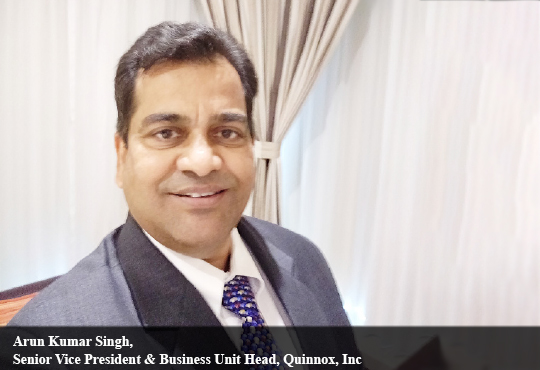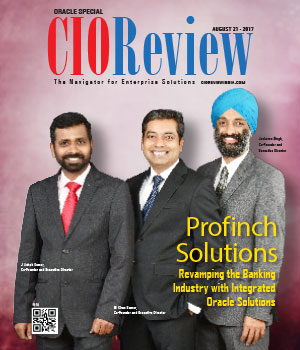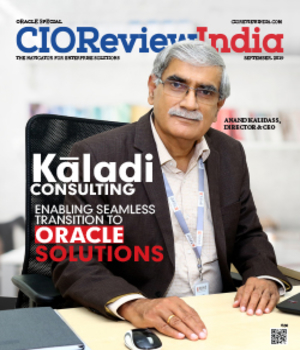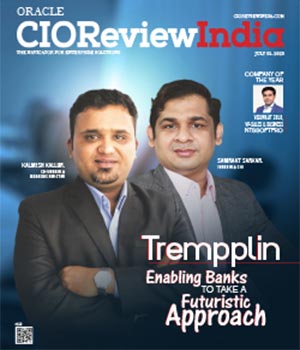
The Impact Of Digital Disruption Technologies On Customer Preferences
Arun Kumar Singh, Senior Vice President & Business Unit Head, Quinnox, Inc | Monday, 16 September 2019, 07:18 IST
 Customer's preferences in association with their need define their shopping behaviour. While individual customers may not ponder much over their preferences i.e. why they like one product or service over another, marketing professionals find it of immense importance. Appealing to the preference of customers is a basic marketing technique. Customer preferences is key input to marketing mix design, and it can help predict both, likelihood and quantity of product/service that can be sold.
Customer's preferences in association with their need define their shopping behaviour. While individual customers may not ponder much over their preferences i.e. why they like one product or service over another, marketing professionals find it of immense importance. Appealing to the preference of customers is a basic marketing technique. Customer preferences is key input to marketing mix design, and it can help predict both, likelihood and quantity of product/service that can be sold.
Research has been carried out for ages to understand different factors that affect the customer preferences. These factors included variables such as income, social groups, lifecycle stage, buyer's impulse etc. Digital disrupting technologies have become an important factor impacting preferences.
Often due to the industrial mindset, where a producer creates a product or service, markets it and the customer buys from a limited set of variants, it was assumed that the customer preferences are static or at least do not change rapidly. As digital disruption empowers the customer like never before, there is a need to move to customer-centric mindset, to understand the rapid effects of digital disrupting technologies on customer preferences. This understanding will guide the marketing initiatives. For technology solution creators too, it's important to understand the use-case defining customer preferences.
“Customer attitudes and demographics are changing. Customers are becoming choosier and expect greater business transparency and corporate responsibility.”
Customer preference may be defined as reason that the customers use to make choices when they are selecting a product or service. This includes likes, dislikes, expectations, priorities, morals, values, motivations, and inclinations. The customer preferences influence the decision during the shopping, and thereafter too. The experience with the product/service bought further shapes the preferences. The 3rd platform (ref IDC) technologies are in the hand of customers. This availability of technology and its experience is impacting customer preferences.
A simple framework may be used to group the preferences and study the impact of any stimulus, including technology. This framework groups the preferences aligned to the phases of the purchase cycle. The three groups that the customer preferences get exhibited with respect to are the product/service itself, the process of buying it and also the experience after having bought it.
Digital Disruptions impact on the Product/Service feature related preferences
Customers are telling what they want. Customers expect the price to go down. While for the new and innovative products/services customers are willing to pay a premium they prefer the price for business-as-usual product/services to reduce continuously. If technology constraints are preventing reduction in price, then expectation is to innovate/create replacement products.
Customer expect their need or want to get satisfied in the most convenient way. Many devices and services needed expertise to use. They expect the design focus on better UI/UX leading to systems which are intuitive and easy to use, e.g. gesture control of devices. With minimal input they expect the desired response from the system/service. With abundance of choices, the tolerance towards reliability and performance is almost zero. The vocal customers today instantaneously share their bitter experience, thus influencing the potential buyers. The services is expected to be available 24X7. Any product/ service is expected by customers to save time, effort and thus to be efficient. In this environment of technology evolution customer expect their product and service to be easily upgradable to newer version/changes and remain compatible with interfacing systems.
Digital Disruptions impact on the Purchase Process related preferences
The digital technology has disrupted the traditional buying process. e-Commerce has brought in an easier and convenient way to do shopping, setting baseline expectation for customers. The effort that the customer was putting has significantly come down while maximizing his satisfaction by letting him order from and get it delivered at home. Technologies have given the choice of many interfaces to do the business. True omni-channel is made available to the customer. Customers prefer reordering to be very simple and intuitive, which the technology allows with easy storage and retrieval of the customer’s past purchase records. The risk appetite of the customers has come down. The “as a service” offerings have eliminated the need to buy and store systems/products at home while allowing 24X7 availability. Value has become very intrinsic to the customer. They will buy what aligns with his value system. The information about the alternate options are at customer’s fingertips hence the need to compromise on value has reduced.
Digital Disruptions impact on the Purchase Process related preferences
When a customer gets in touch with the after-sales service team they expect empathy and understanding from them. Customer would expect a fairness in pricing and information during the service/contract period. One simple way to create the feeling of fairness is to have transparency and openness. No one likes to be held captive, thus the customer would prefer to have a feeling of being in control and be the one who is making the decisions. This would mean having multiple options to choose from. Making choice will need information, hence it important for an enterprise to provide information in a way that the customers can easily use it. The customers will like to have easily accessibility to support people. Finally, all customers will prefer to have good end-to-end experience.
In conclusion, we have seen the impact of digital technologies on customer’s preferences and behaviour, by categorizing them in three groups aligned with purchase cycle. Customer attitudes and demographics are changing. Customers are becoming choosier and expect greater business transparency and corporate responsibility. Increased comfort with technology and a high usage of online channels is feeding this shift. I believe the catch phrase “customer is king” was never so true before.
CIO Viewpoint
New Age CIO - Key Element Of Business Growth
By Mohan Iyer, CIO, Mesirow Financial
Diligent It Adoption For Maximum Gain
By Patrick Quinn, CIO, Acuity Brands Lighting
Cloud for Accelerated Business Intelligence
By Neeraj Verma, IT Director - Platform & Analytics, NCR Corporation
CXO Insights
Enhanced Database Technology in Business...
By Srikanth Doranadula, Group Vice President-Technology and Systems, Oracle India
ISVs driving the dream of a tech-first world in...
By Vivek Gupta, Senior Director and Country Head, Oracle IaaS and PaaS Services, Oracle India
Connect To Succeed: The Future Of Iot In Supply...









